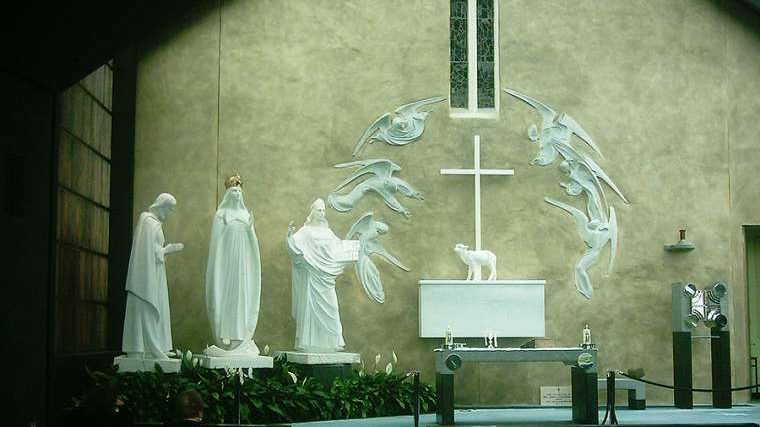As Ireland grapples with high rates of depression and suicide, Irish filmmakers point to the Knock Shrine as a place of hope and healing.
“We want to put Our Lady, our Blessed Mother, front of stage for the Irish people and the world as a beacon of hope. We want this film to be a message for people that there is hope,” Aidan Gallagher, CEO of EWTN Ireland told CNA.
“Hope,” a new docudrama produced by EWTN, tells the story of the Knock apparition.
On a very rainy August 21, 1879, 15 official witnesses saw an apparition of the Virgin Mary, St. Joseph, St. John the Evangelist, angels, and Jesus Christ (as the lamb of God) on the south gable of the town church, which was named St. John the Evangelist. For a period of about two hours, a crowd gathered to adore the apparition and to pray the rosary. Despite the rainstorm, the ground around the gable did not get wet.
Unlike most other Marian apparitions, the Virgin Mary was silent the entire time and did not offer any sort of message or prophesy. Some have theorized that she was silent due to the cultural changes occurring in Ireland at the time--the oldest of the 15 witnesses could only speak the Irish language, and the youngest, who was only six years old at the time, was being taught only English.
Vatican officials found the apparition at Knock to be “trustworthy and satisfactory” after two separate commissions; in 1879 and again in 1936.
The new film contextualizes the apparition with the sufferings endured by the Irish people in the 19th century, particularly in County Mayo, which was hit especially hard by the potato famine.
The Great Famine of 1845-1849 devastated Ireland resulting in the deaths of an estimated 1 million people, with 1 million more emigrating from the country by 1951.
Recurring famines plagued Ireland in the decades that followed, particularly in the northwest. The year 1879, when the apparition took place, was itself “a famine year” for the Irish people.
“When Mary appeared at Knock in 1879, she brought light and hope to the Irish people, and she did so at a time of great darkness,” Gallagher said.
“Today it could be said that there is another famine or blight over Ireland, a spiritual one. We have a massive problem of suicides, as well as depression. It has been called a national crisis,” he said.
Ireland has the highest rate of chronic depression among young people in E.U. countries. The latest Eurofound statistics state 12% of Irish between the ages of 15 and 24 were chronically depressed.
Northern Ireland, where Miller is based, has one of the highest suicide rates in the world. Knock Shrine is just under 70 miles from the Northern Ireland border.
“This film shows us that no matter how desperate we are or how serious our circumstances through Mary there is hope -- hope in Christ,” Gallagher said.
The film’s director, Campbell Miller, said that Ireland and the world need this sense of hope “now more than ever.”
“We hope to give the young people who get a chance to watch this [the message] that there is a sense of hope, that things can get better,” Miller told EWTN News.
A statue of Our Lady of Knock was present on the altar of St. Peter’s Basilica for the papal Mass for the Sunday of the Word of God on Jan. 26.
The rector of Knock Shrine, Fr. Richard Gibbons, traveled to Rome for the Mass and attended the Vatican premiere of the film Jan. 27.
“The Word of God is important in the apparition,” Gibbons told EWTN, noting that St. John appeared preaching the word of God, alongside Mary, in the apparition at Knock.
The Irish priest also highlighted the Eucharistic message of the apparition, in which a lamb appeared on top of an altar and in front of a cross.
“The message is Eucharistic .... the Mass is so important. During the penal times, the persecution of Catholics in Ireland, there was a saying, in Irish. The saying was 'For the Irish, it is the Mass that matters.' So the Mass maintained the faith of the people during very, very bad times in terms of our faith,” he said.
The film also tells the story of a miraculous healing involving Eucharistic adoration that occured at Knock Shrine in 1989 and was officially recognized in Sept. 2019.
Marion Carroll, a woman who had been bedridden for years with multiple sclerosis, was healed during a blessing with a monstrance at Knock Shrine.
Fr. Gibbons said that the Knock Shrine, built on the site of the 1879 apparition, is a place where many people find spiritual healing and peace by reencountering the sacraments.
On average, 4,000 confessions take place each week at the shrine.
“At Knock people come to confession all the time. I call it our engine room -- that's where the miracles happen and the dynamic happens -- in the confessional,” Gibbons said. “People that come to Knock wouldn't even think about going to confession, but they see others going ... it gives them such peace and hope and joy that they in turn then speak that to other people.”
“It is a place of hope, a place of peace, and a place of reconciliation. That is what Knock offers to people,” Fr. Gibbons said.

